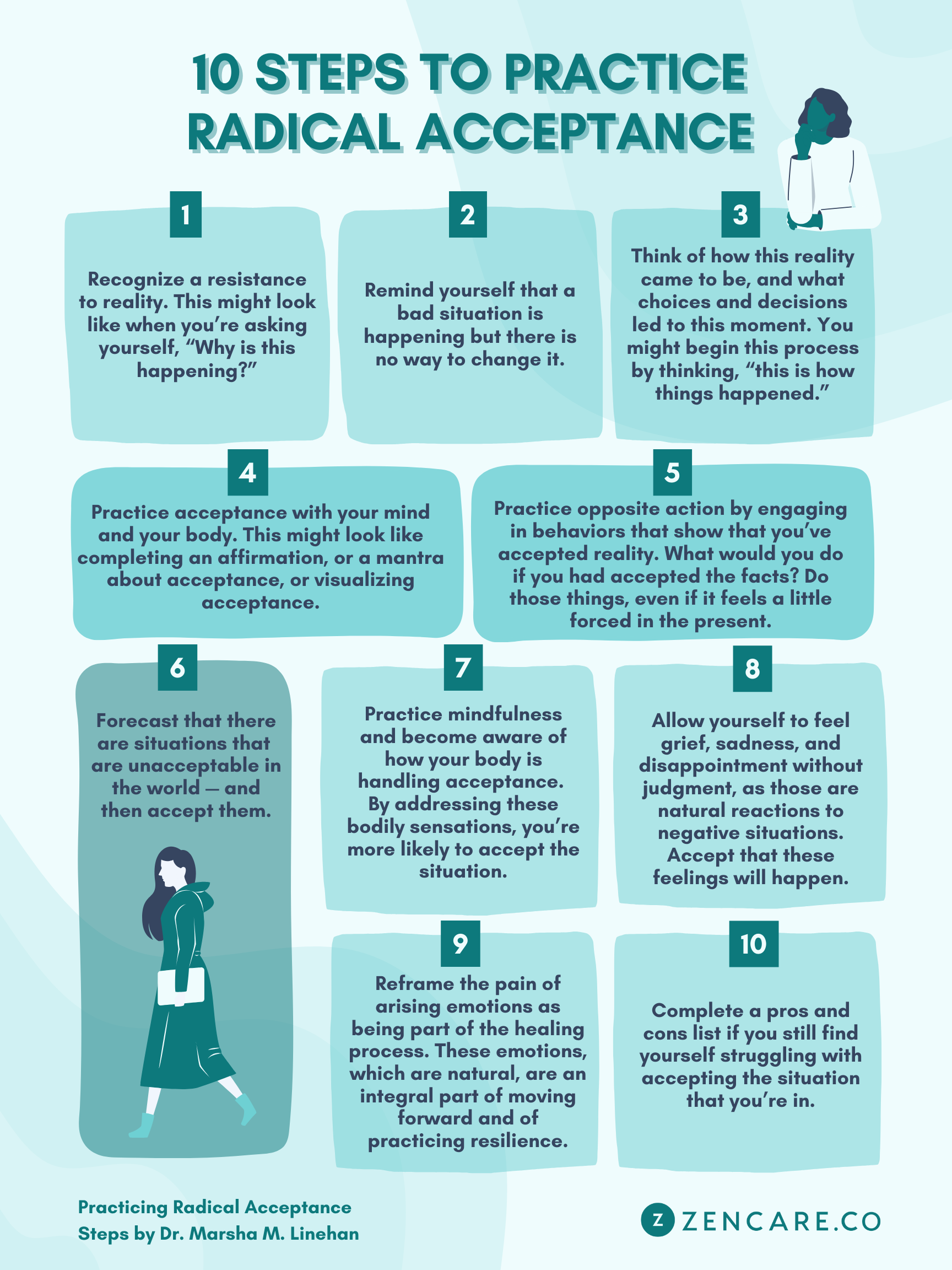Published: March 26, 2024 by Zencare Team
It’s raining outside and you forgot your umbrella. At work, you spill coffee all over your lap, and then have to redo a report you spent most of last week putting together. When you leave the office, it’s still raining, which has made your commute twenty minutes longer.
By looking at each one of these events as misfortune, it would be easy for your mood to slip downwards and even towards assumptions about your own competence. If misery loves company, then suffering loves self-blame. Radical acceptance is a way to turn around that suffering and to change your mindset in the face of uncontrollable situations.

What is radical acceptance?
Radical acceptance is a mindset shift that sees suffering from pain as optional. While pain is a given in life, it doesn’t have to take a toll on your mental health.
Applying radical acceptance to a given situation means acknowledging that the situation isn’t ideal and noting the resulting experiences of negative emotion or distress as a way to understand what is out of your control. The only thing within your control is your reaction to what’s happening, and by accepting that things are the way they are, you may be able to reduce negative outcomes.
When people dwell on situations that they don’t have the power to change — the weather, the economy, the actions of other people — they might either ignore that the situation is happening or wish that things were different (and that things were better). This leaves no room for moving forward from the situation and making meaning out of what’s happening, which may result in feelings of despair. Ultimately, questions like, “Why is this happening to me?” won’t change reality.
The key to radical acceptance is not to place judgment on yourself because of the situation. When someone practices radical acceptance, they acknowledge that the situation is bad and that it’s causing negative feelings, but resist blaming themselves for either. Instead, they accept that things are happening that aren’t great, but there’s nothing they can do about it, so it’s best to keep moving forward. This non-attachment reduces the amount of suffering caused by adverse experiences.
Toxic positivity vs. radical acceptance
Toxic positivity is the idea that no matter how bad or difficult a circumstance might be, maintaining a positive mindset or outlook is crucial, whereas radical acceptance is simply applying the idea that you may not be in control of something that is happening to you, and that you accept that’s the circumstance.
Toxic positivity can look like pressuring someone to be optimistic during a challenging period of their life, like losing a loved one. It can also look like someone regularly saying, “well, look on the bright side” or “it could always be worse” or “everything happens for a reason!”. Not only can this perspective be extreme, but it can also be harmful.
Radical acceptance means applying the idea that you may not be in control of something that is happening to you, and that you accept that’s the circumstance. When practicing radical acceptance, you can still have a negative or positive or neutral outlook on the situation but continue to move forward so that you can minimize the amount of suffering or judgement you might have otherwise experience.
Is radical acceptance part of DBT?
Radical acceptance is a concept that comes from Dialectical Behavioral Therapy (DBT), a therapy approach commonly used to treat bipolar disorder and borderline personality disorder. In DBT, therapists teach their clients how to manage their emotions in healthy ways. Distress tolerance skills such as radical acceptance are ways that clients learn how to sit with uncomfortable feelings and process through them rather than surrender to unhealthy coping patterns.
That said, anyone can practice and benefit from radical acceptance. By changing your attachment to pain or discomfort, you can control the amount of suffering that you experience, and that’s helpful no matter what’s happening in your life.
How to use radical acceptance
There are many ways to use radical acceptance and the most effective way will depend on the individual and the given situation. For many people, learning about radical acceptance and understanding its power can be enough to overcome the pain of certain events. For others, having a structured way of engaging with this skill is the most helpful, particularly when they’re overwhelmed by what’s happening around them.
10 steps to practicing radical acceptance
There are 10 steps to practicing radical acceptance described by DBT’s creator, Dr. Marsha Linehan, in her book DBT Skills Training Handouts and Worksheets, which was originally published in 2015. These steps give individuals a straightforward path to applying radical acceptance as a distress tolerance skill to strengthen their reactions to negative experiences.
We've created a radical acceptance worksheet for you to use when practicing the 10 steps of radical acceptance:
- Recognize a resistance to reality. This might look like when you’re asking yourself, “Why is this happening?”
- Remind yourself that a bad situation is happening but there is no way to change it.
- Think of how this reality came to be, and what choices and decisions led to this moment. You might begin this process by thinking, “this is how things happened”.
- Practice acceptance with your mind and your body. This might look like completing an affirmation, or a mantra about acceptance, or visualizing acceptance.
- Practice opposite action by engaging in behaviors that show that you’ve accepted reality. What would you do if you had accepted the facts? Do those things, even if it feels a little forced in the present.
- Forecast that there are situations that are unacceptable in the world — and then accept them.
- Practice mindfulness and become aware of how your body is handling acceptance. By addressing these bodily sensations, you’re more likely to accept the situation.
- Allow yourself to feel grief, sadness, disappointment without judgment, as those are natural reactions to negative situations. Accept that these feelings will happen.
- Reframe the pain of arising emotions as being part of the healing process. These emotions, which are natural, are an integral part of moving forward and of practicing resilience.
- Complete a pros and cons list if you still find yourself struggling with accepting the situation that you’re in.
Radical acceptance affirmations
Another way to practice radical acceptance is the use of radical acceptance affirmations. Affirmations are positive statements that directly contradict or combat negative thoughts, particularly negative thoughts about the self. They are generally used to shift mindsets towards the positive, and there are many radical acceptance affirmations that can be helpful in challenging situations.
When bad things happen, it’s easy to resort to these negative thoughts like, “What did I do to deserve this?” or “This is my fault.”
Radical acceptance affirmations instead frame the situation as inevitable and out of your control, taking the blame off your shoulders and instead acknowledging that sometimes life has its bad moments. Here are a few radical acceptance affirmations to try:
- “I can't change what’s happening and I can’t change the past.”
- “I will get through this situation even though I don’t like it.”
- “I’m strong and I’m choosing to overcome this roadblock.”
- “I’m making good decisions in the face of challenge because I’m good at taking care of myself.”
- “Even though today is really hard, I can still be happy in my life.”
By using these affirmations — even when you’re not completely sold on them — your mindset can shift, which can lead to greater meaning, healing, and moving forward.
When to use radical acceptance
There are many circumstances where using radical acceptance is helpful, and most of those circumstances are when other people are involved, as we cannot control how other people think, act, or feel. Radical acceptance is also helpful to use when facing situations brought about by nature, such as natural disasters, or when hearing about current events happening around the globe.
Here are a few situations where radical acceptance is a useful tool to use:
- When thinking back on a difficult childhood or an adverse experience in the past
- When a natural disaster your house or impacts your community
- When your company goes through layoffs
- When a family member becomes sick or faces health challenges
It’s important to note that practicing radical acceptance does not mean that you’re giving up. It means that you’re deciding to actively adjust your mindset for the benefit of your well-being. In many cases, like when faced with a medical diagnosis, you may still go through treatment or engage various interventions, all while using a radical acceptance mindset to cope with the situation. Radical acceptance is also different from approving of the situation or condoning what’s happening.
When NOT to use radical acceptance
There are many situations where radical acceptance is not an appropriate tool to use and can have harmful impacts on one’s mental health and well-being. The non-attachment stance radical acceptance suggests is not healthy when in physical or emotional danger, the following are some examples of those scenarios.
- Abusive relationships. These relationships can have severe mental health consequences and sometimes even cause physical harm. While other people’s actions are theirs to control, it's unhealthy to accept abuse, as no one should have to experience it.
- Burnout. Overwhelming work stress and burnout can become detrimental to well-being and have long term consequences if not directly addressed and treated.
- Harassment. If you are being harassed at all, or your safety is compromised and threatened, you should not use radical acceptance to cope. It is dangerous to not take action or confide in a trusted person what you are experiencing.
Acceptance should not become a scapegoat for inaction. Life comes with good parts and bad parts and determining when you have the power to change things reveals when radical acceptance is appropriate. If you have the power to change your situation, that’s generally the best course of action. And if not, then accepting the situation might help you keep going.
Therapy and radical acceptance
Radical acceptance can be challenging to do on your own, as it’s a complex mindset that takes practice to internalize. While radical acceptance is a mainstay in DBT, it’s also found in other therapy approaches and used by many therapists to support their clients’ well-being. Its core is based in mindfulness, which opens the door to many other mindfulness practices and mindfulness therapies.
If you’re looking to begin practicing radical acceptance in your life, working with an experienced therapist can be immensely helpful. Therapists are a great resource for talking through challenging situations and processing through the emotions that come with those experiences. Using the Zencare therapist directory, you can find therapists in your area that can help you shift your mindset.Taking one more look at your day, radical acceptance changes the perception of each event. It's inevitable that some days will be rainy, and sometimes mugs just slip out of hands. Having to make changes to a report shows that the work matters, and you were always going to have to commute home anyway. By using a perspective of acceptance over the things outside of your control, suffering can become resilience.
